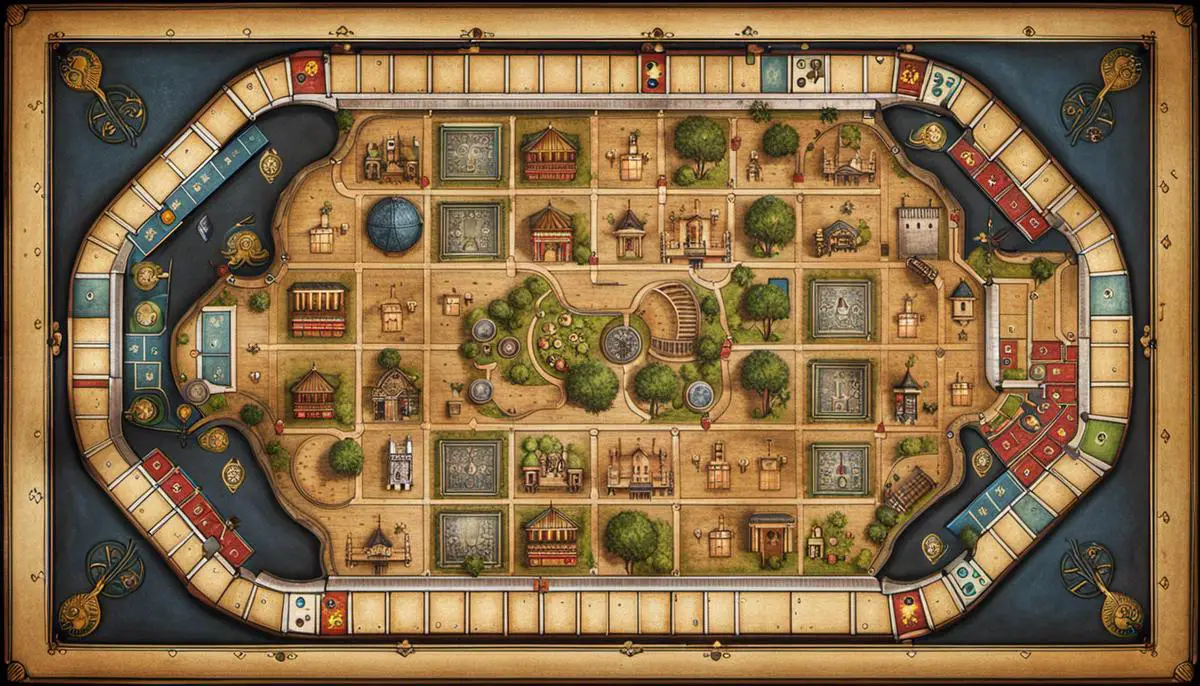In times of yore, amidst the military might and architectural grandeur of the Roman Empire, citizens and soldiers sought both solace and tension in the strategic worlds of board games. From the bustling steps of the Basilica Iulia to the intimate confines of homely atriums, many a battle was fought, not upon fields of war, but within the carefully delineated realms of boards and pieces. Of these, three games claimed commendable popularity—Ludus Latrunculorum, Tabula, and Duodecim Scripta. Each unique and provocative, these games were not mere distractions; they were arenas for ingenuity, tactical prowess and a relentless pursuit of victory.
Ludus Latrunculorum
Ludus Latrunculorum: Brain Teaser of The Roman Era
Ludus Latrunculum was indeed a game that demands a blend of strategy and trickery to secure a victory. It’s often referred to as ‘The Game of Robbers’, perhaps in reference to its intriguing mix of stealth, strategy, and warfare.
One notable aspect of Ludus Latrunculorum is that it was played on a rectangular board. The pieces used during gameplay had different power levels, similar to chess or draughts nowadays. The varied power levels of the pieces allowed for a diverse range of strategies and moves, making it a highly engaging pastime.
Historical Relevance: A Game for All in Ancient Rome
Evidence of the popularity of Ludus Latrunculorum amongst various demographics is observable. Roman soldiers and ordinary civilians were both known to enjoy the game, speaking to its universal appeal. One notable archeological find in this context was the sight of boards for this game scratched into the steps of the Basilica Iulia. The location of these boards in the heart of the Roman Forum implies the game was a common cultural touchstone.
Fading From Sight but Not Memory: The Game’s Twilight Years
Despite the game’s popularity during the Roman Empire, its decline coincided with the fall of the Western Roman Empire. But while it vanished from common practice, Ludus Latrunculorum never completely faded from history. The game was preserved and even played in certain pockets of the world.
Overall, Ludus Latrunculorum stands as a fascinating artifact of cultural history, offering insights into leisure activities during the Roman Empire. It serves as a telling reminder of how humans across eras have enjoyed strategic gameplay, often using the same basic principles that underpin popular modern board games.

Tabula
Delving into Tabula: A Classic Roman Board Game
Frequently enjoyed during the Roman Empire, Tabula holds a significant place in gaming history. Regarded as the genetic predecessor to our present-day backgammon, Tabula was keenly appreciated and widely played throughout the Roman realm. This popular ancient game beautifully blended elements of luck and strategic gameplay that never failed to keep Roman citizens captivated.
One of the distinguishing features that set Tabula apart was the unique layout of its game board. It comprised twenty-four points arranged in three separate sections, quite similar to the structure we observe in modern backgammon boards. Each player had fifteen pieces at their disposal and the game progressed with the roll of three dice, which decidedly added to the element of chance.
Another intriguing element to note is the likely reference to Tabula as ‘alea’, translating to ‘dice’, in Roman texts. Many historians and gaming enthusiasts argue that it was this board game that the Roman authors frequently alluded to when they wrote about the popular dice-oriented gambling games of their time.
The compelling blend of strategy and good fortune that Tabula offered is one of the reasons it remained a cherished pastime in Roman society. Players all across the board, young and old, enjoyed the exciting experience that the ebb and flow of each match brought to the table. It truly encapsulates the spirit of ancient Roman game culture.
Whether played casually among friends or more competitively in gambling scenarios, Tabula managed to capture the attention of its players and continues to leave a lasting legacy even in our modern era. Its functionality, appeal, and social context are indicative of Rome’s love for board games. It neatly showcases a pivotal chapter of antique leisure activities highlighting the ingenuity of Roman society.
As we enjoy a game of backgammon today, Tabula serves as a shared entertainment link binding us to our ancient counterparts. This fascinating board game remains a standing testimony to the engaging pastimes enjoyed throughout the Roman culture, marking an interesting point of concurrency between modern and ancient recreational times.

Duodecim Scripta
Game Overview: Duodecim Scripta
The ancient Roman game Duodecim Scripta, or Game of Twelve Lines, captivated gamers with its strategic, immersive gameplay. Players rolled three dice and moved their pieces around a board composed of two sets of twelve lines. This setup, somewhat similar to present-day backgammon, added an exciting twist to this Roman pastime – the race wasn’t over until one player had successfully removed all of their pieces from the board.
Archaeological Evidence of Gameplay
Past civilizations not only enjoyed Duodecim Scripta, they placed a high premium on their gaming equipment. Archaeologists have unearthed game boards forged from diverse materials ranging from wood to precious metal, showing the extent of gamers’ devotion. These boards were frequently adorned with intricate carvings and designs, signaling that they were more than just game tools. They were objects of art and symbols of status.
Popularity During Roman Era
The Roman board game Duodecim Scripta was not just a random diversion; it was an essential part of leisure time. It held a unique position in the world of Roman entertainment and delivered a gaming experience that was tactile, visual, and intellectual all at once, adding to its wide appeal. Evidence of its popularity is reflected in the range of materials used and the finesse shown in the game boards that have been discovered. Duodecim Scripta provided a perfect blend of strategy and chance, offering everybody a fair chance at victory. It remains an engaging window into Roman recreation and an enduring reminder of how ancient societies kicked back and had fun.
Modern-day Connections
Even centuries on, the thrill of Duodecim Scripta lives on in modern board games. The compelling mixture of skill and luck that characterized this early Roman game is seen in contemporary favorites like backgammon. Despite its ancient roots, Duodecim Scripta offers timeless, universal gaming appeal that keeps us intrigued. Its legacy provides a rich insight into historical recreational activities and the sense of camaraderie and competition inherent in games, past and present.

The echoes of Ludus Latrunculorum, Tabula and Duodecim Scripta linger on today, shadowing contemporary equivalents like chess and backgammon. Their essence resides not only in the stone etchings or remnants uncovered by archaeologists, but indeed, within the very core of our modern gaming landscape. As we fondly delve back into the annals of the Roman Empire, reimagining the tactics and teasing tension of these remarkable board games, the past comes alive with a refreshing vigor. Thus, as we navigate the infinite landscape of learning about these historical pastimes, we engage not merely with an erstwhile empire, but with an enduring legacy of strategy, competition, and compelling human interaction.
